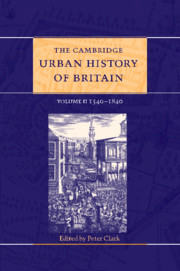Book contents
- Frontmatter
- 1 Introduction
- Part I Area surveys 1540–1840
- Introduction
- 2(a) England: East Anglia
- 2(b) England: South-East
- 2(c) England: South-West
- 2(d) England: Midlands
- 2(e) England: North
- 3 Wales
- 4 Scotland
- Part II Urban themes and types 1540–1700
- Part III Urban themes and types 1700–1840
- Select Bibliography
- Index
- References
3 - Wales
from Part I - Area surveys 1540–1840
Published online by Cambridge University Press: 28 March 2008
- Frontmatter
- 1 Introduction
- Part I Area surveys 1540–1840
- Introduction
- 2(a) England: East Anglia
- 2(b) England: South-East
- 2(c) England: South-West
- 2(d) England: Midlands
- 2(e) England: North
- 3 Wales
- 4 Scotland
- Part II Urban themes and types 1540–1700
- Part III Urban themes and types 1700–1840
- Select Bibliography
- Index
- References
Summary
The chapter examines a paradox: towns played a very significant role in Welsh social and economic life, but before about 1760, the towns that mattered most were not located on Welsh soil. This account will describe the limited importance of the specifically Welsh towns, and the strikingly small urban population of the principality. It will then discuss the networks that did exist in terms of the English regional capitals, especially Bristol, Shrewsbury and Chester; and finally, show how a distinctively Welsh urban network appeared in the south-eastern parts of the country by the end of the eighteenth century.
WELSH URBAN STRUCTURE 1540–1750
Welsh towns were deceptively numerous. As Matthew Griffiths remarks, ‘medieval Wales had been endowed with far more boroughs and market centres than its economy could justify’, the abundance reflecting the need to attract settlers, and many towns withered within a century or two of creation. Nor could they long maintain their position as islands of Norman or English influence, and Ralph A. Griffiths has shown how the later medieval boroughs became increasingly integrated into rural Welsh society. By 1540, a lengthy process of winnowing had left a small number of thriving urban centres, alongside dozens of places lacking the social or economic basis to justify their urban pretensions.
Some fifty or sixty towns in Tudor and Stuart Wales held regular markets, but we reach this figure only by including communities with 200 or 300 people. In 1756, William Owen’s Authentic Account cited fairs at 167 centres throughout the principality, seventy of which were located in the three shires of Carmarthen, Denbigh and Caernarvon.
- Type
- Chapter
- Information
- The Cambridge Urban History of Britain , pp. 133 - 150Publisher: Cambridge University PressPrint publication year: 2000

